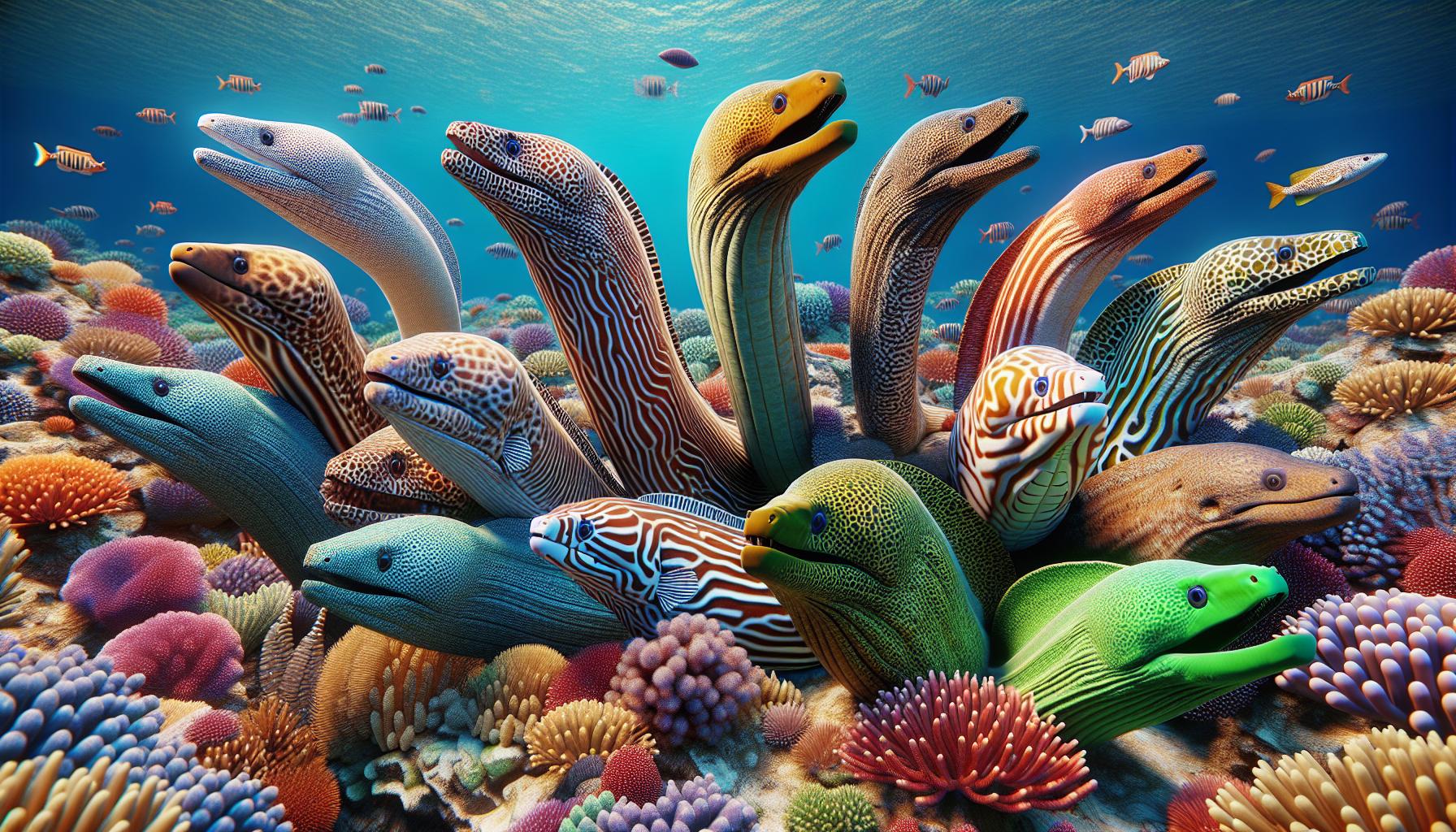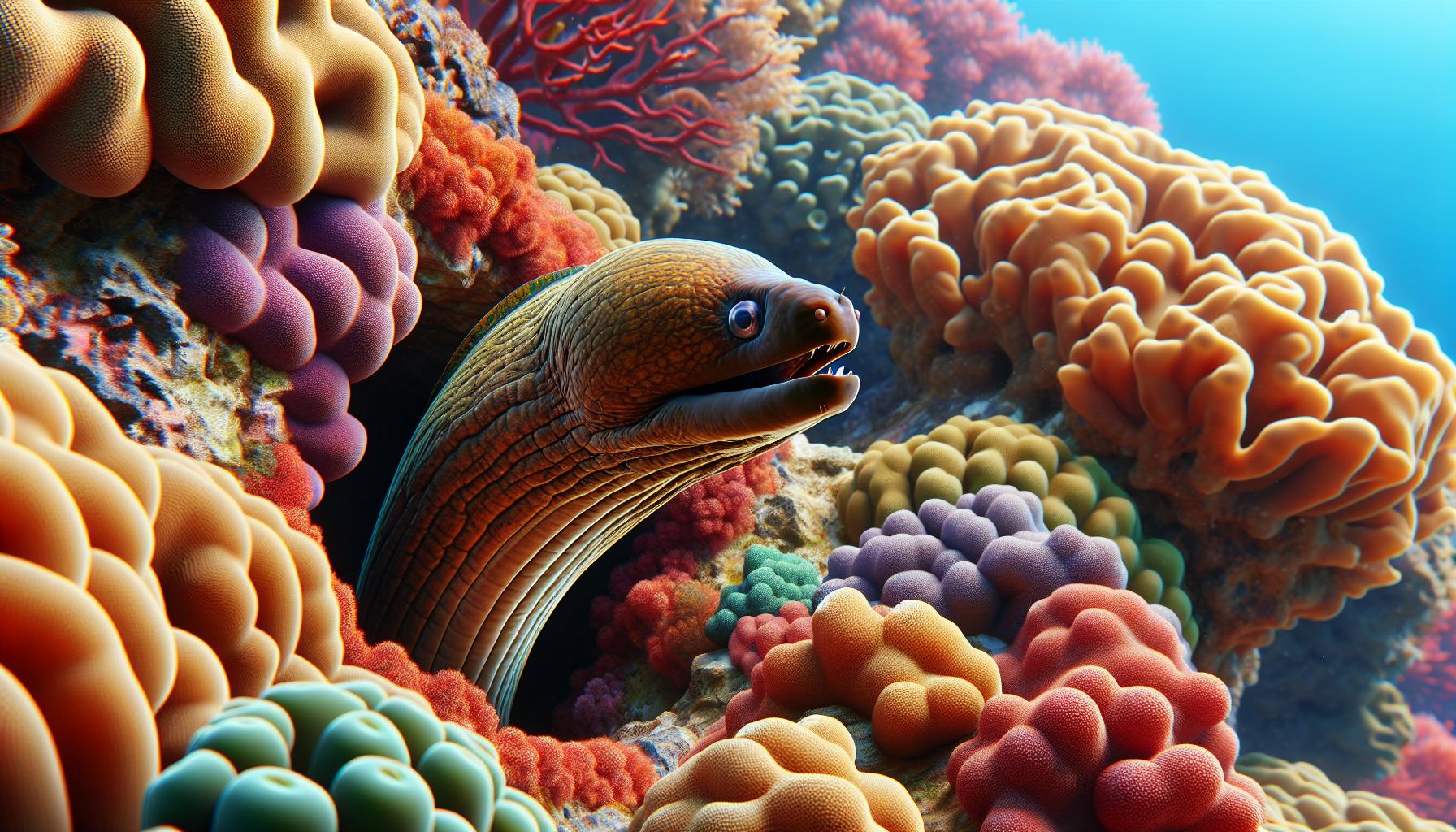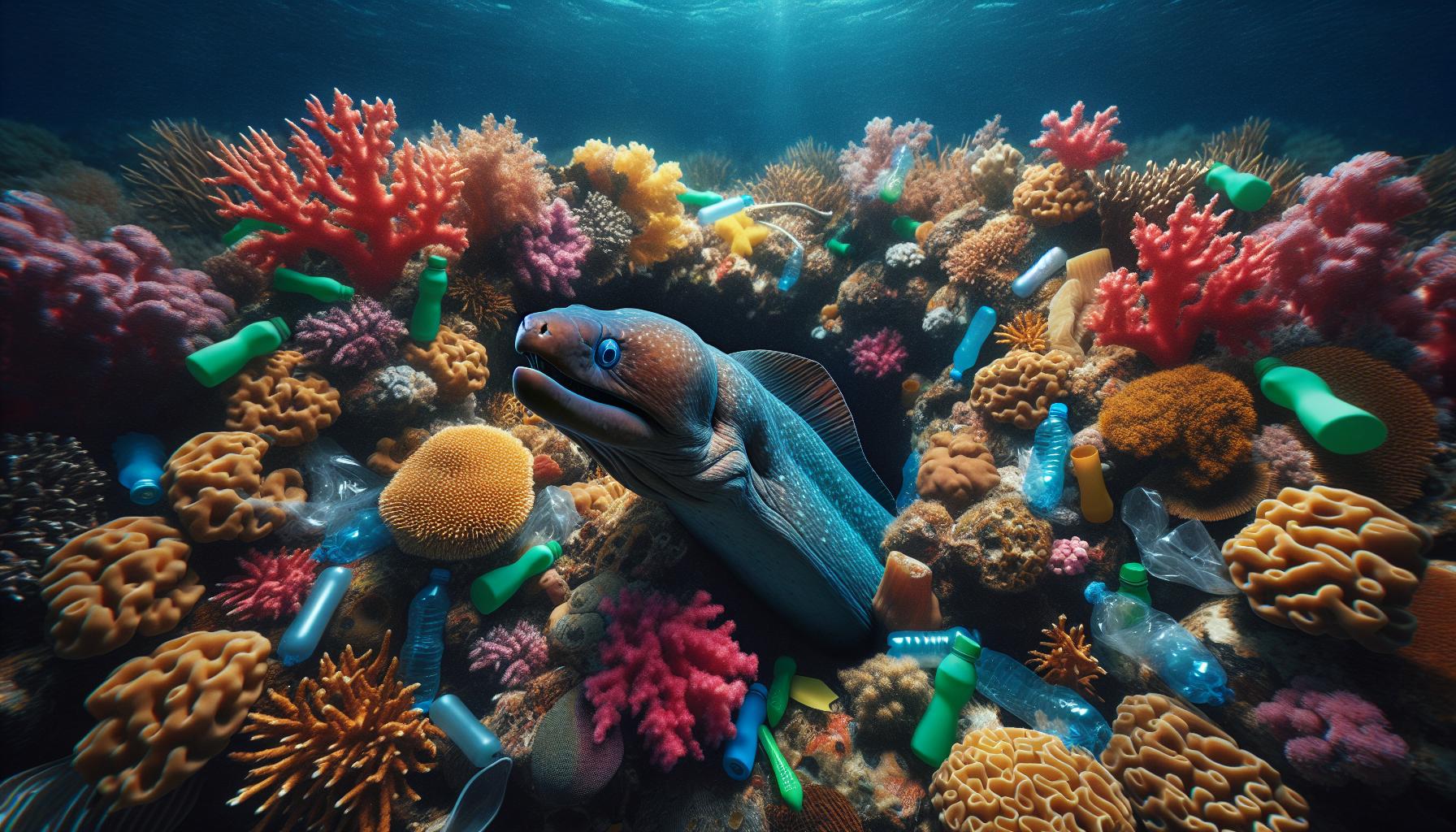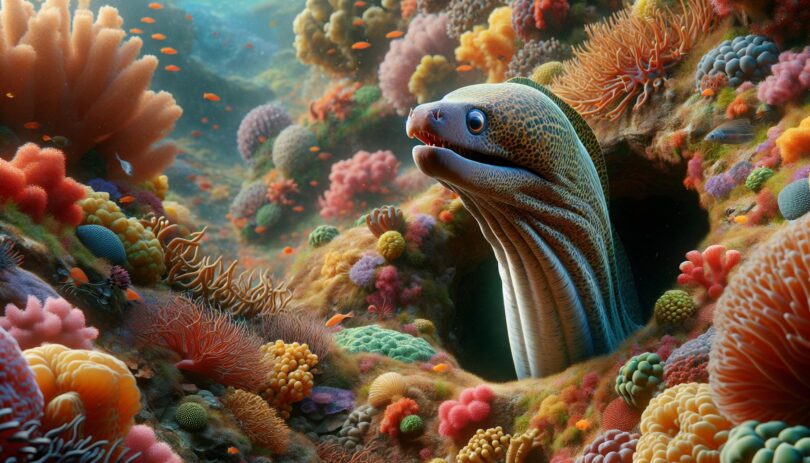Moray saltwater eels, with their serpentine bodies and impressive jaws, are one of the ocean’s most fascinating creatures. Found in warm and temperate seas around the world, they’ve captured the imagination of divers and marine enthusiasts alike. I’ve always been intrigued by their mysterious nature and the myths surrounding them.
Diving into the world of moray eels, I’ve discovered there’s much more than meets the eye. From their unique hunting methods to their surprising social behaviors, these eels are a testament to the wonders of marine life. Join me as we explore the captivating world of moray saltwater eels.
Key Takeaways
- Moray saltwater eels are a diverse group with over 200 species, showcasing a wide range of sizes, colors, and behaviors adapted to different marine environments.
- Key physical adaptations such as their serpentine body, efficient respiratory system, and varied tooth structures, enable moray eels to thrive as predators within coral reefs and rocky ocean floors.
- Moray eels are found in a broad range of habitats across tropical and subtropical waters worldwide, indicating their adaptability and significance in maintaining marine ecosystem health.
- Their unique hunting strategies, including cooperative hunting with other species and the use of secondary pharyngeal jaws, demonstrate the complexity and innovation in their feeding habits.
- Social behaviors during the breeding season, like the formation of spawning balls, highlight the rare moments of social interaction among these predominantly solitary creatures.
- Environmental threats such as pollution, habitat destruction, and bycatch pose significant challenges to moray eel populations, underscoring the need for conservation efforts to ensure their survival.
Types of Moray Saltwater Eels

Diving into the diverse world of moray eels, it’s fascinating to learn that there are over 200 species, each adapted to specific environments. These species range in size, color, and behavior, making them a subject of continuous study and intrigue.
One of the most renowned species is the Giant Moray Eel, which can grow up to 10 feet long. This species is a sight to behold, with its formidable size and a mouth full of sharp teeth, primarily inhabiting reefs in the Indo-Pacific area. On the other end of the spectrum, the Snowflake Eel, often found in the aquarium trade, is smaller and known for its intricate and beautiful pattern that resembles a winter snowflake.
Moray eels also exhibit a wide range of colors and patterns. The Zebra Moray, for example, is marked with striking black and white stripes, living up to its name. Meanwhile, the Green Moray boasts a vibrant green skin that’s actually a coating of yellow mucus over dark skin, which helps protect it from parasites and infection.
Here’s a quick glance at some notable species:
| Species | Max Length | Distinct Feature |
|---|---|---|
| Giant Moray Eel | 10 ft | Large size, sharp teeth |
| Snowflake Eel | 3 ft | Intricate snowflake-like patterns |
| Zebra Moray | 5 ft | Black and white stripes |
| Green Moray | 8 ft | Vibrant green skin |
The diversity among moray eels demonstrates their adaptability and the wide range of niches they occupy within marine ecosystems. Each species brings something unique to its habitat, whether it’s their method of hunting, their social behavior, or simply their stunning appearance. As I continue to explore the lives of these fascinating creatures, it’s clear that their variety is as deep and complex as the waters they dwell in.
Physical Characteristics and Adaptations

When delving into the world of moray saltwater eels, their physical characteristics and adaptations stand out as truly remarkable. As I’ve explored these creatures, their diversity in size, color, and form amazed me. However, certain physical traits are common across most species, enabling them to thrive in their respective marine habitats.
Firstly, moray eels possess a long, slender body, which allows them to navigate the crevices and tunnels of coral reefs with ease. This serpentine form is not just for navigation; it’s a strategic adaptation for ambushing prey. Their skin is also of note; it’s thick, slimy, and generally lacks scales, a trait that reduces friction as they glide through water and tight spaces.
One of the most fascinating adaptations is their respiratory system. Moray eels have a highly efficient way of breathing that involves drawing water through their mouths and expelling it through their gill openings. This method allows them to remain stationary and hidden within crevices for long periods, waiting for the perfect moment to strike at passing prey.
Their teeth are another feature that can’t be ignored. Depending on the species, moray eels’ teeth can vary from sharp, needle-like points perfect for grabbing slippery fish and crustaceans to flat, molar-like teeth designed for crushing hard-shelled prey. The Giant Moray Eel, for example, has razor-sharp teeth that enable it to feed on a variety of sea creatures, including other eels.
Below is a comparison of tooth structures in two notable species:
| Species | Tooth Structure |
|---|---|
| Giant Moray | Sharp, Needle-like |
| Zebra Moray | Flat, Molar-like |
Moray eels’ camouflage abilities are another key adaptation. Their skin patterns and colors mimic the textures and shadows of their environments, making them nearly invisible to both prey and predators. This ability not only aids in hunting but in protection as well.
Habitat and Distribution
When I dive into the world of moray saltwater eels, I discover an array of habitats as vast and diverse as the oceans themselves. These creatures have a broad distribution, thriving in both tropical and subtropical waters worldwide. From the shallow, sunlit reefs of the Caribbean to the murky depths off the coast of Australia, moray eels have made nearly every marine environment their home.
One of the fascinating aspects of moray eels is their penchant for hidden, protective spaces. They prefer crevices in rocky reefs and the safety of coral formations. It’s not uncommon for me to spot them peeking out of holes, their sleek bodies just barely visible. This behavior isn’t just a preference; it’s a survival strategy. By staying hidden, moray eels can ambush unsuspecting prey, making them formidable predators in their ecosystems.
The depth range in which moray eels are found is equally impressive. They reside in waters as shallow as 2 meters, ideal for snorkelers hoping for a glimpse, to depths of up to 150 meters. This adaptability to various water conditions underscores their evolutionary success.
Here’s a quick glance at the distribution of moray eels across different regions:
| Region | Depth Range (meters) | Notable Species |
|---|---|---|
| Caribbean | 2-40 | Green Moray Eel |
| Indo-Pacific | 2-150 | Giant Moray Eel |
| Mediterranean | 5-50 | Mediterranean Moray |
Their widespread presence across global seas speaks to their incredible adaptability and the role they play in maintaining the health of marine ecosystems. Whether navigating the vibrant coral reefs in search of prey or lying in wait within the shadowy confines of a rocky cave, moray eels have mastered the art of survival in the ocean’s varied landscapes.
Feeding Habits and Hunting Strategies

When I delve into the world of moray eels, their feeding habits and hunting strategies truly stand out as remarkable adaptations that have enabled them to thrive in various marine environments. These carnivorous creatures primarily feed on fish, octopuses, and crustaceans. What’s fascinating is their method of capturing prey, which showcases their cunning and adaptability.
Moray eels employ a unique hunting technique known as cooperative hunting. They sometimes partner with other marine predators, like groupers, to flush out prey from crevices or coral reefs. This strategy significantly increases their chances of a successful hunt, showcasing an unexpected level of interspecies cooperation.
One of the most striking features of moray eels is their pharyngeal jaws. Unlike most fish, moray eels have a second set of jaws located in their throat, which they use to grasp prey and pull it into their esophagus. This mechanism is not only fascinating but also a superb adaptation for a predator that needs a secure grip on slippery prey.
Moray eels also use ambush tactics to catch their meals. They typically hide within crevices, with only their head protruding, waiting patiently for an unsuspecting victim. Once a target is within reach, they strike swiftly, minimizing the chance for their prey to escape.
Their diet varies depending on the species and the ecosystem they inhabit. Here’s a quick overview:
| Species | Diet |
|---|---|
| Green Moray Eel | Mainly fish and cephalopods |
| Giant Moray Eel | Fish, octopuses, and crustaceans |
| Ribbon Eel | Small fish and invertebrates |
This diet diversity is essential for the health of marine ecosystems, as moray eels help maintain the balance by controlling the population of their prey. Their presence ensures a dynamic and healthy ocean, where energy and matter flow efficiently through food webs. As I continue to explore the intricate lives of these fascinating creatures, it’s clear that their survival strategies are as varied and complex as the ecosystems they inhabit.
Social Behaviors and Reproduction
When I dove deeper into the study of moray saltwater eels, I discovered fascinating facets of their social behaviors and reproductive practices. Moray eels are predominantly solitary creatures, a trait that significantly shapes both their social interactions and reproduction strategies. Solitary doesn’t mean antisocial; in fact, during certain times, morays exhibit remarkable social behaviors, especially during the breeding season.
Moray eels’ breeding season is not fixed and can vary depending on the species and environmental conditions, such as water temperature and food availability. Despite their loner nature, morays come together in a rare display of social interaction during this time. Their mating ritual is a complex dance, where multiple eels intertwine with each other in what’s known as a spawning ball. This behavior is not only a spectacle but also indicative of their cooperative approach during reproduction.
Reproduction in moray eels involves external fertilization, where females release eggs into the water, and males release sperm to fertilize the eggs. This method disperses a large number of eggs into the ocean, although it results in a low survival rate for the offspring due to predation and other environmental factors. Here are some key points about their reproduction:
- Mating Season: Varies by species and environmental conditions
- Fertilization: External
- Offspring Survival Rate: Low due to high predation
Post-fertilization, moray eel larvae, known as leptocephali, drift in the open ocean for months before settling on the reef. This planktonic stage of their lifecycle makes them vulnerable, yet it is crucial for the dispersion and genetic diversity of the species. Over time, these larvae transform into the slender, elongated juveniles that eventually settle into their own crevice on the reef, marking the start of a solitary life.
The study of moray eels’ social behaviors and reproduction sheds light on the delicate balance between their solitary nature and the moments of unity required for the continuation of their species. Their complex mating dances and reproductive strategies are essential in sustaining their populations and maintaining the diversity and health of marine ecosystems.
Threats and Conservation Status

When discussing the majestic moray saltwater eel, it’s equally important to shed light on the challenges they face in their natural habitats. Despite their tough appearance and savvy hunting skills, these creatures aren’t immune to environmental threats and human activities.
Pollution, particularly plastic and chemical runoff, poses a significant danger to moray eels. The ocean’s cluttered state impacts their health and the abundance of their prey, affecting their overall well-being and survival rates. Furthermore, coastal development and the destruction of coral reefs reduce the essential hiding and hunting grounds moray eels rely on, pushing them toward endangerment.
Another considerable threat comes from overfishing and bycatch. Although moray eels are not typically targeted by commercial fisheries, they often become unintended victims caught in nets and fishing lines meant for other species. This not only reduces their population directly but also disrupts their natural feeding behaviors and diet.
The International Union for Conservation of Nature (IUCN) has listed several moray eel species with varying degrees of concern, but data is lacking for many, suggesting a need for ongoing research and monitoring. Conservation efforts are crucial, emphasizing habitat preservation, pollution control, and enforcing fishing regulations to mitigate bycatch.
Efforts to understand and protect moray eels are gaining momentum. Marine protected areas (MPAs) offer a beacon of hope, providing safe havens that help preserve their natural behaviors and breeding grounds. These initiatives, alongside global cooperation and a commitment to sustainable ocean practices, are vital for the future of these fascinating marine creatures.
Through continued research and conservation efforts, there’s hope for securing a stable environment for moray eels, ensuring their mysterious allure remains a hallmark of healthy reefs and oceans around the world.
Conclusion
Moray eels are fascinating creatures with unique adaptations and behaviors that play a vital role in marine ecosystems. Their complex life cycle, from the mysterious spawning ball ritual to the perilous journey of their larvae, underscores the challenges these species face in the wild. As threats like pollution and overfishing loom large, it’s clear that protecting moray eels isn’t just about conserving a single species—it’s about safeguarding the health of our oceans. The role of marine protected areas and international cooperation can’t be overstated in this effort. By understanding and appreciating the intricate lives of moray eels, we’re taking a crucial step towards a future where both these remarkable creatures and their underwater worlds can thrive.
Frequently Asked Questions
Are moray eels social or solitary creatures?
Moray eels are predominantly solitary, spending most of their time alone in crevices. However, they exhibit social behaviors during breeding season, where they can be seen intertwining with others in a unique spawning ball.
How do moray eels reproduce?
Moray eels reproduce through external fertilization. During the breeding season, females release eggs into the water, and males release sperm to fertilize them. This method results in a spawning ball as part of their mating ritual.
What is the survival rate of moray eel offspring?
The survival rate of moray eel offspring is low, primarily due to predation. After fertilization, larvae drift in the open ocean, facing various predators before settling on the reef.
Why is the dispersion and genetic diversity of moray eels important?
The dispersion of moray eel larvae and their genetic diversity are crucial for the species’ survival. Drifting in the open ocean before settling on reefs allows for a wider distribution and reduces the risk of inbreeding, promoting a healthier population.
What are the major threats to moray eels?
Major threats to moray eels include pollution, coastal development, overfishing, and bycatch. These factors adversely affect their population and habitat, posing significant challenges for their survival.
How can the conservation of moray eels be ensured?
Conservation of moray eels can be ensured through ongoing research, habitat preservation, pollution control, and enforcing fishing regulations. Establishing marine protected areas and promoting global cooperation are also key in protecting these species and their habitats.

